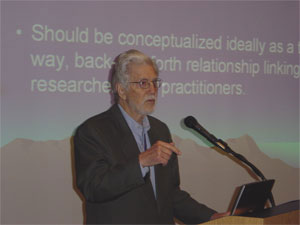NIDA's National Drug Abuse Treatment Clinical Trials Network (CTN) has as its overriding mission improving the quality of drug abuse treatment. Results from the earliest CTN trials, examining such treatment methods as motivational interviewing, motivational incentives, and buprenorphine therapy, are imminent, as is the need to move those CTN research results into clinical practice. To that end, the CTN Dissemination Subcommittee met in January to discuss effective dissemination strategies.
 Dr. Everett M. Rogers, Regents Professor of Communications and Journalism at the University of New Mexico in Albuquerque, and an expert in the field of innovation diffusion, spoke in January at the CTN Dissemination Subcommittee meeting. Dr. Rogers noted that the CTN has a solid framework in place for disseminating innovations in drug abuse treatment.
Dr. Everett M. Rogers, Regents Professor of Communications and Journalism at the University of New Mexico in Albuquerque, and an expert in the field of innovation diffusion, spoke in January at the CTN Dissemination Subcommittee meeting. Dr. Rogers noted that the CTN has a solid framework in place for disseminating innovations in drug abuse treatment.In his welcoming remarks, NIDA Deputy Director Dr. Timothy Condon said that collaborations are already under way between NIDA and the Addiction Technology Transfer Centers (ATTCs), which are funded by the Substance Abuse and Mental Health Services Administration. Dr. Condon described groups of researchers, clinicians, and experts in technology transfer working together in "blending teams" to help clinicians adopt CTN-tested protocols. These teams have begun work to increase awareness about buprenorphine as a treatment modality and to facilitate the use of the Addiction Severity Index as an outcome assessment tool.
Dr. Everett M. Rogers, Regents Professor of Communications and Journalism at the University of New Mexico in Albuquerque, a leading expert on how innovations are diffused, has studied the process for 50 years. Dr. Rogers calls the CTN an ideal "dissemination scaffold" in light of the link already in place between researchers and practitioners. According to Dr. Rogers, characteristics of an innovation that is adopted include the following:
- It confers a relative advantage compared with current practice;
- It is compatible with other current practices;
- It is of relatively low complexity;
- It is possible for the potential adopter to try before adopting; and
- As a consequence of trying the innovation, the potential adopter sees positive results.
Dr. Rogers emphasized that when an innovation in drug abuse treatment is adopted by a new user, "reinvention is inevitable." CTN teams that have tested interventions to treat drug abuse should thus anticipate that the interventions will be modified by those who adopt them. In fact, the CTN teams should see this process as beneficial to dissemination, according to Dr. Rogers.
Dr. Paul Roman, Distinguished Research Professor at the University of Georgia in Athens, concurred with Dr. Rogers on the importance of understanding the provider's point of view when planning to disseminate a clinical innovation. Dr. Roman is now studying how involvement in CTN research affects community treatment programs. His research has shown that treatment programs with a greater tendency to adopt innovations are those whose managers scan the environment—journals and educational conferences—for new information and are attentive to maintaining high levels of patient satisfaction.
When the experts were asked to comment on the CTN's dissemination plans, they responded favorably: With its collaboration of researchers and providers in the design of studies, the extensive network of community treatment programs within the CTN, and the partnership between NIDA and the ATTCs, they said, the CTN is uniquely positioned to improve drug abuse treatment.
